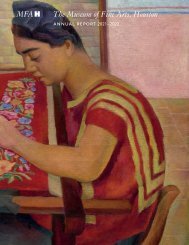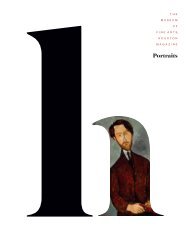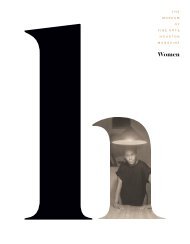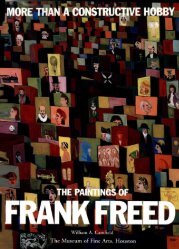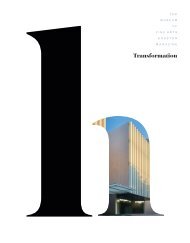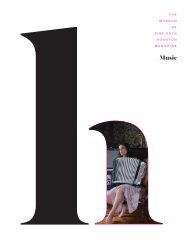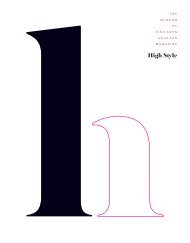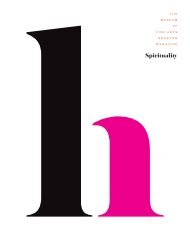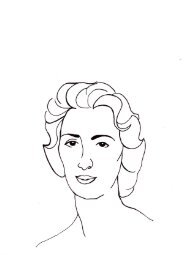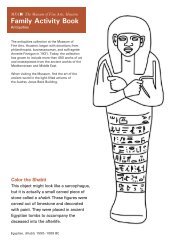Create successful ePaper yourself
Turn your PDF publications into a flip-book with our unique Google optimized e-Paper software.
If marks of perfection confirm Buddhahood, earthly traits on<br />
the same figure recount his life’s journey for enlightenment. He<br />
was born Siddhartha Gautama in 6th century BC, regent to a<br />
north Indian kingdom at the foothills of the Himalayans. <strong>The</strong><br />
prince enjoyed a life of luxury at the palace, was married, and<br />
wore fine garments and gold jewelry. A Buddha figure always<br />
acknowledges this early life with extended ear lobes, which<br />
were once weighted to the shoulders under heavy earrings (see<br />
page 35).<br />
Such extreme care was taken to shield him from life’s sufferings<br />
that the prince did not encounter sickness, old age,<br />
and death until he was 29 years old. Those “Four Encounters,”<br />
the fourth being a wandering ascetic, launched his quest for<br />
enlightenment, in search of an end to the human predicament<br />
of suffering. Having left the palace in the cover of night,<br />
he removed his jewels and cut off his hair in a symbolic act of<br />
renouncing earthly possessions and familial ties. <strong>The</strong> remaining<br />
tufts on his shorn head curled neatly in the characteristic<br />
“snail shells” pattern (see page 34). In place of courtly attire,<br />
Siddhartha wore two rectangular cloths wrapped around his<br />
body, typically with one shoulder bare. Buddhist nuns and<br />
monks to this day, as they set intentions to imitate the Buddha,<br />
undergo ritual head shaving, don versions of Buddha’s simple<br />
garment, and renounce personal wealth.<br />
Siddhartha lived the life of a wandering ascetic for six years.<br />
Having exhausted the practice of extreme austerity, he arrived<br />
at the Middle Path, rejecting both sensual indulgences and<br />
debilitating self-denial. He revived his emaciated body with a<br />
bowl of rice pudding, and then sat down to meditate under<br />
a sacred tree in Bodh Gaya. <strong>The</strong>re, he reached a profound<br />
insight: the sufferings of life are caused by egocentric desires,<br />
and the path to salvation consists of shedding those delusions.<br />
By awakening to the true nature of reality, he attained liberation<br />
from the endless cycle of rebirth. He became the “Awakened<br />
One,” the Buddha.<br />
Some of the most dynamic Buddhist sculptures ever created<br />
depict this moment (as seen at left). Under the boughs of the<br />
Bodhi tree, the Buddha sits cross-legged in deep concentration.<br />
He is surrounded by trouble. <strong>The</strong> demon Mara, standing<br />
with a long bow, first threatens the Buddha with fear, his<br />
grotesque soldiers hurling weapons; then Mara tempts him<br />
with desire, as personified by his alluring daughters. Remaining<br />
immovable, the Buddha extends his right hand to touch the<br />
ground, asking Earth to witness his awakening.<br />
<strong>The</strong> 6th-century Indian sculptor dramatized the moment<br />
with visual contrasts. <strong>The</strong> Buddha is composed of pure<br />
shapes. <strong>The</strong> Diamond Seat (a rectangle) supports the seated<br />
Buddha (a triangle), topped with a halo (a perfect circle). In<br />
contrast, Mara and his cohorts are a mangled mass, all curves<br />
and twisted lumps. <strong>The</strong> smooth and unadorned Buddha, as<br />
if swelling from a breath within, appears luminous against<br />
the pitted and shadowed frame of figures.<br />
<strong>The</strong> Buddha is the center of the narrative, yet he exists<br />
beyond the fray, being at once of the moment and timeless.<br />
In fact, when extracted from the scene of the battle,<br />
the Earth-Touching Buddha (below) is one of the most<br />
repeated icons in Buddhism. His immobile pose and blissful<br />
introspection model a state of being: by mastering the mind,<br />
one may defeat the inner demons of fear and desire. <strong>The</strong><br />
Buddha figure thus embodies his teaching.<br />
<strong>The</strong> sculptures from the Xuzhou Collection (pronounced<br />
“shoe-joe”) present extraordinary range and unparalleled<br />
quality. <strong>The</strong> collector, himself a student of Buddhism, named<br />
the collection in Chinese, meaning “Empty Boat”—a reminder<br />
that the sculptures themselves manifest Buddhist teaching.<br />
Looking beyond the apparent material splendor, viewers are<br />
alerted to the sculptures’ potential to teach and to transform.<br />
37<br />
Height: 20 1/2”<br />
Icon of Enlightenment<br />
Abstracted from the scene of the battle, the Earth-Touching Buddha<br />
remains one of the most iconic images in Buddhism, offering reassurance<br />
in the human struggle against fear and desire.




